Analyzing Leadership and Management in Google's Operations: A Report
VerifiedAdded on 2020/12/29
|18
|3532
|463
Report
AI Summary
This report delves into the operational management of Google, examining the distinct roles and characteristics of leaders and managers. It begins by comparing and contrasting these roles, highlighting their responsibilities in achieving organizational goals. The report then analyzes various leadership theories, including situational, contingency, and systems leadership, and how they apply within Google's environment. Real-world examples illustrate how leaders and managers function in different situations, such as labor turnover and conflict resolution. Furthermore, the report explores how leaders and managers can improve operational efficiencies to meet business objectives. The analysis covers key approaches to operations management, factors impacting the business environment, and the strengths and weaknesses of different leadership approaches within the workplace. Ultimately, the report offers a comprehensive overview of leadership and management in Google's operational context, providing insights into effective strategies and practices.

Management and Operations
Paraphrase This Document
Need a fresh take? Get an instant paraphrase of this document with our AI Paraphraser
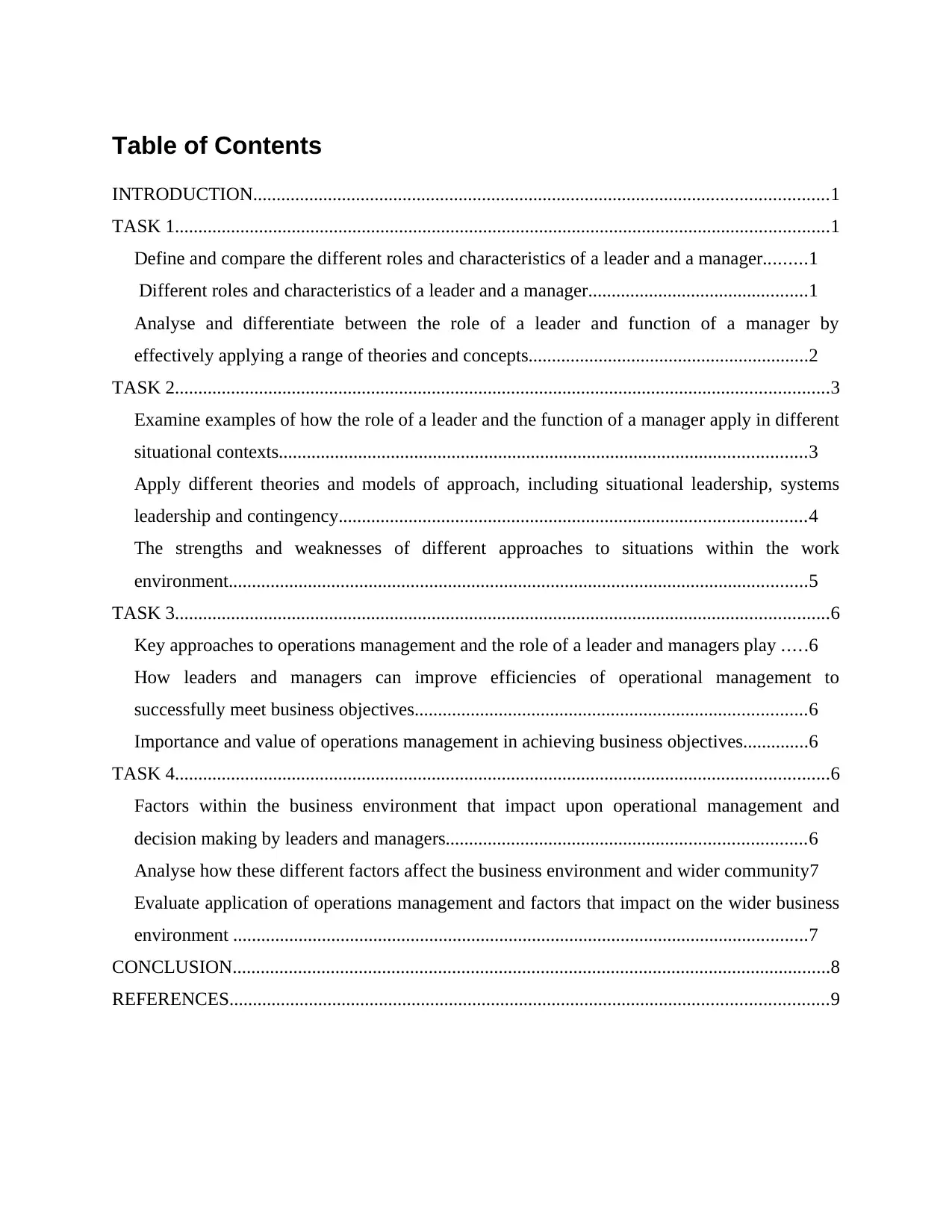
Table of Contents
INTRODUCTION...........................................................................................................................1
TASK 1............................................................................................................................................1
Define and compare the different roles and characteristics of a leader and a manager.........1
Different roles and characteristics of a leader and a manager...............................................1
Analyse and differentiate between the role of a leader and function of a manager by
effectively applying a range of theories and concepts............................................................2
TASK 2............................................................................................................................................3
Examine examples of how the role of a leader and the function of a manager apply in different
situational contexts.................................................................................................................3
Apply different theories and models of approach, including situational leadership, systems
leadership and contingency....................................................................................................4
The strengths and weaknesses of different approaches to situations within the work
environment............................................................................................................................5
TASK 3............................................................................................................................................6
Key approaches to operations management and the role of a leader and managers play .....6
How leaders and managers can improve efficiencies of operational management to
successfully meet business objectives....................................................................................6
Importance and value of operations management in achieving business objectives..............6
TASK 4............................................................................................................................................6
Factors within the business environment that impact upon operational management and
decision making by leaders and managers.............................................................................6
Analyse how these different factors affect the business environment and wider community7
Evaluate application of operations management and factors that impact on the wider business
environment ...........................................................................................................................7
CONCLUSION................................................................................................................................8
REFERENCES................................................................................................................................9
INTRODUCTION...........................................................................................................................1
TASK 1............................................................................................................................................1
Define and compare the different roles and characteristics of a leader and a manager.........1
Different roles and characteristics of a leader and a manager...............................................1
Analyse and differentiate between the role of a leader and function of a manager by
effectively applying a range of theories and concepts............................................................2
TASK 2............................................................................................................................................3
Examine examples of how the role of a leader and the function of a manager apply in different
situational contexts.................................................................................................................3
Apply different theories and models of approach, including situational leadership, systems
leadership and contingency....................................................................................................4
The strengths and weaknesses of different approaches to situations within the work
environment............................................................................................................................5
TASK 3............................................................................................................................................6
Key approaches to operations management and the role of a leader and managers play .....6
How leaders and managers can improve efficiencies of operational management to
successfully meet business objectives....................................................................................6
Importance and value of operations management in achieving business objectives..............6
TASK 4............................................................................................................................................6
Factors within the business environment that impact upon operational management and
decision making by leaders and managers.............................................................................6
Analyse how these different factors affect the business environment and wider community7
Evaluate application of operations management and factors that impact on the wider business
environment ...........................................................................................................................7
CONCLUSION................................................................................................................................8
REFERENCES................................................................................................................................9
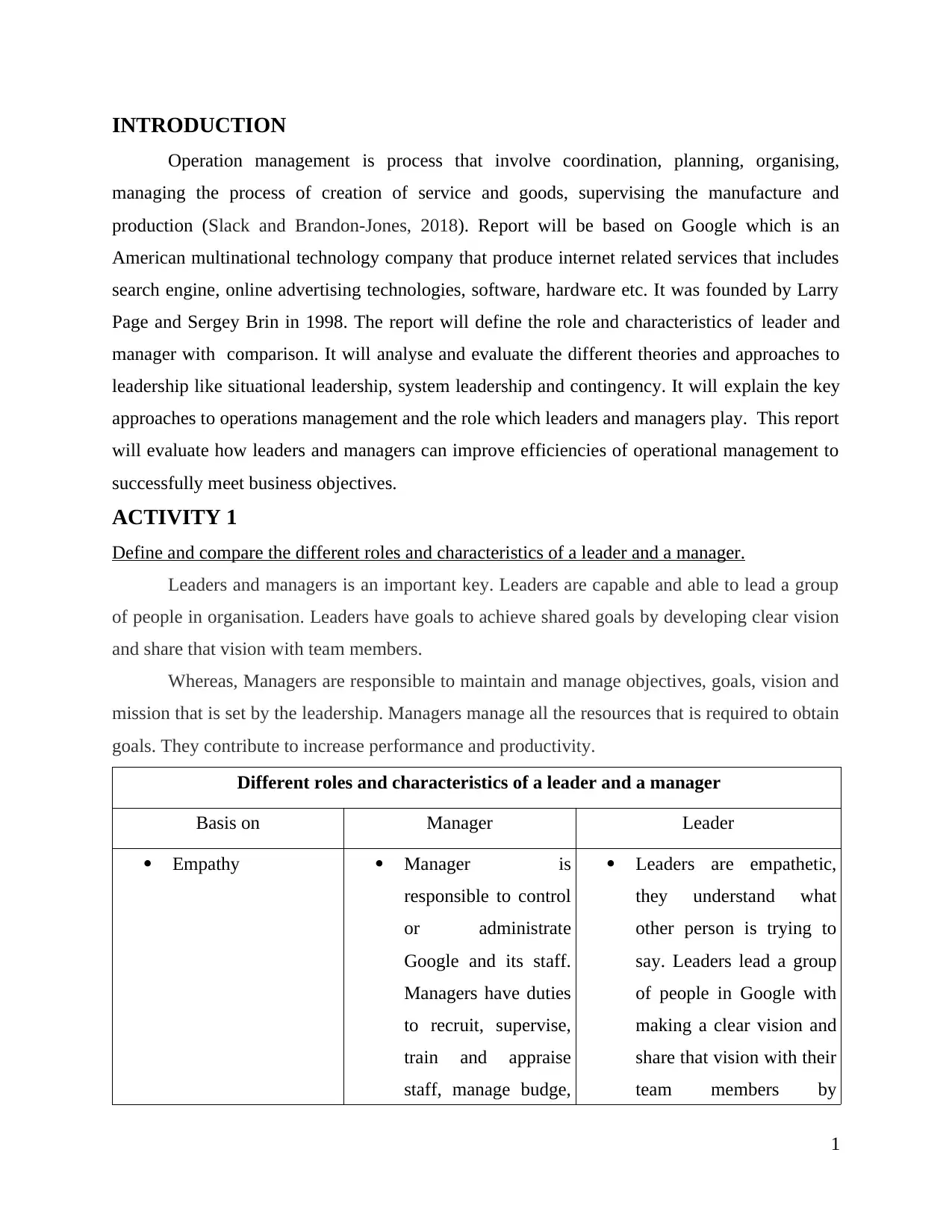
INTRODUCTION
Operation management is process that involve coordination, planning, organising,
managing the process of creation of service and goods, supervising the manufacture and
production (Slack and Brandon-Jones, 2018). Report will be based on Google which is an
American multinational technology company that produce internet related services that includes
search engine, online advertising technologies, software, hardware etc. It was founded by Larry
Page and Sergey Brin in 1998. The report will define the role and characteristics of leader and
manager with comparison. It will analyse and evaluate the different theories and approaches to
leadership like situational leadership, system leadership and contingency. It will explain the key
approaches to operations management and the role which leaders and managers play. This report
will evaluate how leaders and managers can improve efficiencies of operational management to
successfully meet business objectives.
ACTIVITY 1
Define and compare the different roles and characteristics of a leader and a manager.
Leaders and managers is an important key. Leaders are capable and able to lead a group
of people in organisation. Leaders have goals to achieve shared goals by developing clear vision
and share that vision with team members.
Whereas, Managers are responsible to maintain and manage objectives, goals, vision and
mission that is set by the leadership. Managers manage all the resources that is required to obtain
goals. They contribute to increase performance and productivity.
Different roles and characteristics of a leader and a manager
Basis on Manager Leader
Empathy Manager is
responsible to control
or administrate
Google and its staff.
Managers have duties
to recruit, supervise,
train and appraise
staff, manage budge,
Leaders are empathetic,
they understand what
other person is trying to
say. Leaders lead a group
of people in Google with
making a clear vision and
share that vision with their
team members by
1
Operation management is process that involve coordination, planning, organising,
managing the process of creation of service and goods, supervising the manufacture and
production (Slack and Brandon-Jones, 2018). Report will be based on Google which is an
American multinational technology company that produce internet related services that includes
search engine, online advertising technologies, software, hardware etc. It was founded by Larry
Page and Sergey Brin in 1998. The report will define the role and characteristics of leader and
manager with comparison. It will analyse and evaluate the different theories and approaches to
leadership like situational leadership, system leadership and contingency. It will explain the key
approaches to operations management and the role which leaders and managers play. This report
will evaluate how leaders and managers can improve efficiencies of operational management to
successfully meet business objectives.
ACTIVITY 1
Define and compare the different roles and characteristics of a leader and a manager.
Leaders and managers is an important key. Leaders are capable and able to lead a group
of people in organisation. Leaders have goals to achieve shared goals by developing clear vision
and share that vision with team members.
Whereas, Managers are responsible to maintain and manage objectives, goals, vision and
mission that is set by the leadership. Managers manage all the resources that is required to obtain
goals. They contribute to increase performance and productivity.
Different roles and characteristics of a leader and a manager
Basis on Manager Leader
Empathy Manager is
responsible to control
or administrate
Google and its staff.
Managers have duties
to recruit, supervise,
train and appraise
staff, manage budge,
Leaders are empathetic,
they understand what
other person is trying to
say. Leaders lead a group
of people in Google with
making a clear vision and
share that vision with their
team members by
1
⊘ This is a preview!⊘
Do you want full access?
Subscribe today to unlock all pages.

Trusted by 1+ million students worldwide
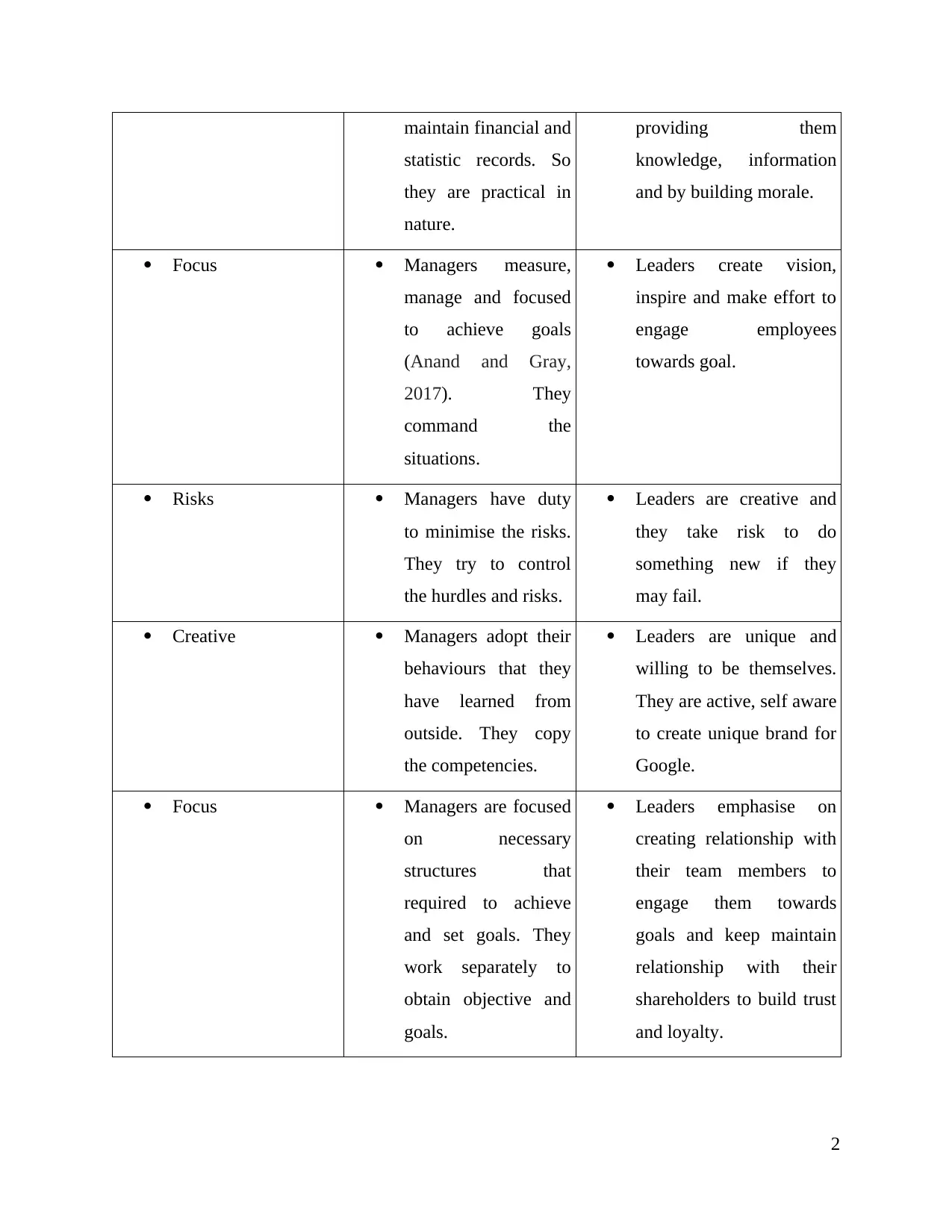
maintain financial and
statistic records. So
they are practical in
nature.
providing them
knowledge, information
and by building morale.
Focus Managers measure,
manage and focused
to achieve goals
(Anand and Gray,
2017). They
command the
situations.
Leaders create vision,
inspire and make effort to
engage employees
towards goal.
Risks Managers have duty
to minimise the risks.
They try to control
the hurdles and risks.
Leaders are creative and
they take risk to do
something new if they
may fail.
Creative Managers adopt their
behaviours that they
have learned from
outside. They copy
the competencies.
Leaders are unique and
willing to be themselves.
They are active, self aware
to create unique brand for
Google.
Focus Managers are focused
on necessary
structures that
required to achieve
and set goals. They
work separately to
obtain objective and
goals.
Leaders emphasise on
creating relationship with
their team members to
engage them towards
goals and keep maintain
relationship with their
shareholders to build trust
and loyalty.
2
statistic records. So
they are practical in
nature.
providing them
knowledge, information
and by building morale.
Focus Managers measure,
manage and focused
to achieve goals
(Anand and Gray,
2017). They
command the
situations.
Leaders create vision,
inspire and make effort to
engage employees
towards goal.
Risks Managers have duty
to minimise the risks.
They try to control
the hurdles and risks.
Leaders are creative and
they take risk to do
something new if they
may fail.
Creative Managers adopt their
behaviours that they
have learned from
outside. They copy
the competencies.
Leaders are unique and
willing to be themselves.
They are active, self aware
to create unique brand for
Google.
Focus Managers are focused
on necessary
structures that
required to achieve
and set goals. They
work separately to
obtain objective and
goals.
Leaders emphasise on
creating relationship with
their team members to
engage them towards
goals and keep maintain
relationship with their
shareholders to build trust
and loyalty.
2
Paraphrase This Document
Need a fresh take? Get an instant paraphrase of this document with our AI Paraphraser

Analyse and differentiate between the role of a leader and function of a manager by effectively
applying a range of theories and concepts.
There are so many theories and model that differentiate the role of leader and function of
managers. Here, some theories which are based on leadership.
Situational Theory: This theory proposed that no single style of leadership is best. It
depends on types of situations that occurs and according to that strategies, leadership and
functions of managers are defined. Leaders adapt the style to engage their team towards goals as
stated in situation while managers set structures that necessary to achieve the goals (Ansoff and
et.al., 2019). Effective leaders inspire employees to be productive and efficient in order to
achieve goals in various circumstances.
Contingency Theory: This theory says the effective management is dependent,
contingent, specific situations and behaviours. It defines importance of personality of leader and
manager and condition that leader and manager operate. In unexpected situation leaders motivate
and engage employees while managers command the situations and minimise the risks.
System Theory: In this theory leaders create a condition, where employees are able to
work at all levels productively. While managers creates flexible working conditions for them.
Management by objective: according to this theory, managers have role to improve
performance of organisation by defining clear objects to employees. For that Managers has to
involve staff in decision making process. That helps employees to understand their roles and
responsibilities.
Examine examples of how the role of a leader and the function of a manager apply in different
situational contexts.
Leaders and managers have different role and functions in different condition and
situation. Both play an important role in Google to achieve goals and profitability (Chiarini,
2015).
Labour Turnover: Labour turnover is about employee retention that is to convince
employees to remain in business. It can measure by percentage rate that is turnover rate. It is
employees percentage that leave workplace during the certain period. Labour turnover increase
due to dissatisfaction with personnel policies, working environment, wages, lack of transport
facilities, medical and others. In Google employees are raising the ethical concern. Due to this,
3
applying a range of theories and concepts.
There are so many theories and model that differentiate the role of leader and function of
managers. Here, some theories which are based on leadership.
Situational Theory: This theory proposed that no single style of leadership is best. It
depends on types of situations that occurs and according to that strategies, leadership and
functions of managers are defined. Leaders adapt the style to engage their team towards goals as
stated in situation while managers set structures that necessary to achieve the goals (Ansoff and
et.al., 2019). Effective leaders inspire employees to be productive and efficient in order to
achieve goals in various circumstances.
Contingency Theory: This theory says the effective management is dependent,
contingent, specific situations and behaviours. It defines importance of personality of leader and
manager and condition that leader and manager operate. In unexpected situation leaders motivate
and engage employees while managers command the situations and minimise the risks.
System Theory: In this theory leaders create a condition, where employees are able to
work at all levels productively. While managers creates flexible working conditions for them.
Management by objective: according to this theory, managers have role to improve
performance of organisation by defining clear objects to employees. For that Managers has to
involve staff in decision making process. That helps employees to understand their roles and
responsibilities.
Examine examples of how the role of a leader and the function of a manager apply in different
situational contexts.
Leaders and managers have different role and functions in different condition and
situation. Both play an important role in Google to achieve goals and profitability (Chiarini,
2015).
Labour Turnover: Labour turnover is about employee retention that is to convince
employees to remain in business. It can measure by percentage rate that is turnover rate. It is
employees percentage that leave workplace during the certain period. Labour turnover increase
due to dissatisfaction with personnel policies, working environment, wages, lack of transport
facilities, medical and others. In Google employees are raising the ethical concern. Due to this,
3
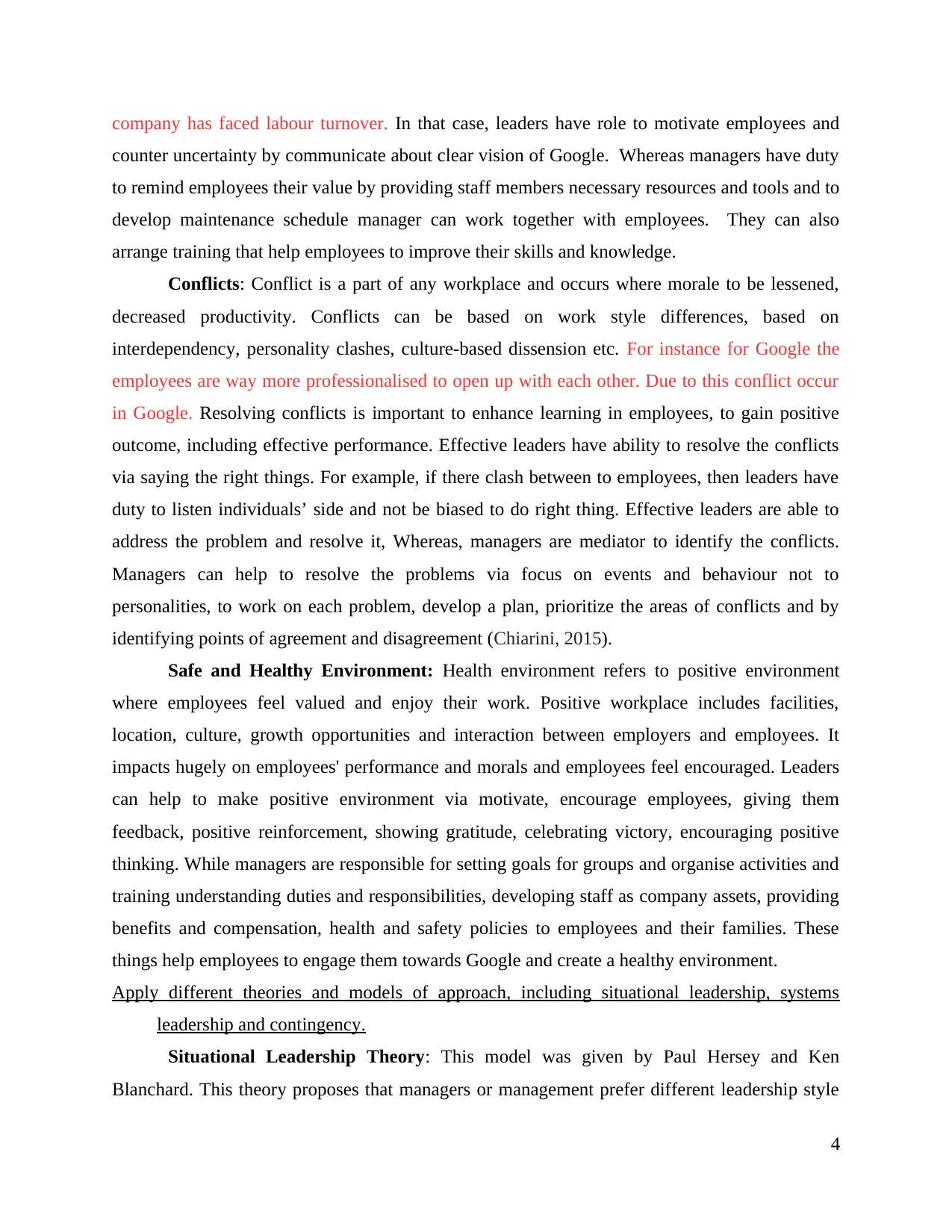
company has faced labour turnover. In that case, leaders have role to motivate employees and
counter uncertainty by communicate about clear vision of Google. Whereas managers have duty
to remind employees their value by providing staff members necessary resources and tools and to
develop maintenance schedule manager can work together with employees. They can also
arrange training that help employees to improve their skills and knowledge.
Conflicts: Conflict is a part of any workplace and occurs where morale to be lessened,
decreased productivity. Conflicts can be based on work style differences, based on
interdependency, personality clashes, culture-based dissension etc. For instance for Google the
employees are way more professionalised to open up with each other. Due to this conflict occur
in Google. Resolving conflicts is important to enhance learning in employees, to gain positive
outcome, including effective performance. Effective leaders have ability to resolve the conflicts
via saying the right things. For example, if there clash between to employees, then leaders have
duty to listen individuals’ side and not be biased to do right thing. Effective leaders are able to
address the problem and resolve it, Whereas, managers are mediator to identify the conflicts.
Managers can help to resolve the problems via focus on events and behaviour not to
personalities, to work on each problem, develop a plan, prioritize the areas of conflicts and by
identifying points of agreement and disagreement (Chiarini, 2015).
Safe and Healthy Environment: Health environment refers to positive environment
where employees feel valued and enjoy their work. Positive workplace includes facilities,
location, culture, growth opportunities and interaction between employers and employees. It
impacts hugely on employees' performance and morals and employees feel encouraged. Leaders
can help to make positive environment via motivate, encourage employees, giving them
feedback, positive reinforcement, showing gratitude, celebrating victory, encouraging positive
thinking. While managers are responsible for setting goals for groups and organise activities and
training understanding duties and responsibilities, developing staff as company assets, providing
benefits and compensation, health and safety policies to employees and their families. These
things help employees to engage them towards Google and create a healthy environment.
Apply different theories and models of approach, including situational leadership, systems
leadership and contingency.
Situational Leadership Theory: This model was given by Paul Hersey and Ken
Blanchard. This theory proposes that managers or management prefer different leadership style
4
counter uncertainty by communicate about clear vision of Google. Whereas managers have duty
to remind employees their value by providing staff members necessary resources and tools and to
develop maintenance schedule manager can work together with employees. They can also
arrange training that help employees to improve their skills and knowledge.
Conflicts: Conflict is a part of any workplace and occurs where morale to be lessened,
decreased productivity. Conflicts can be based on work style differences, based on
interdependency, personality clashes, culture-based dissension etc. For instance for Google the
employees are way more professionalised to open up with each other. Due to this conflict occur
in Google. Resolving conflicts is important to enhance learning in employees, to gain positive
outcome, including effective performance. Effective leaders have ability to resolve the conflicts
via saying the right things. For example, if there clash between to employees, then leaders have
duty to listen individuals’ side and not be biased to do right thing. Effective leaders are able to
address the problem and resolve it, Whereas, managers are mediator to identify the conflicts.
Managers can help to resolve the problems via focus on events and behaviour not to
personalities, to work on each problem, develop a plan, prioritize the areas of conflicts and by
identifying points of agreement and disagreement (Chiarini, 2015).
Safe and Healthy Environment: Health environment refers to positive environment
where employees feel valued and enjoy their work. Positive workplace includes facilities,
location, culture, growth opportunities and interaction between employers and employees. It
impacts hugely on employees' performance and morals and employees feel encouraged. Leaders
can help to make positive environment via motivate, encourage employees, giving them
feedback, positive reinforcement, showing gratitude, celebrating victory, encouraging positive
thinking. While managers are responsible for setting goals for groups and organise activities and
training understanding duties and responsibilities, developing staff as company assets, providing
benefits and compensation, health and safety policies to employees and their families. These
things help employees to engage them towards Google and create a healthy environment.
Apply different theories and models of approach, including situational leadership, systems
leadership and contingency.
Situational Leadership Theory: This model was given by Paul Hersey and Ken
Blanchard. This theory proposes that managers or management prefer different leadership style
4
⊘ This is a preview!⊘
Do you want full access?
Subscribe today to unlock all pages.

Trusted by 1+ million students worldwide
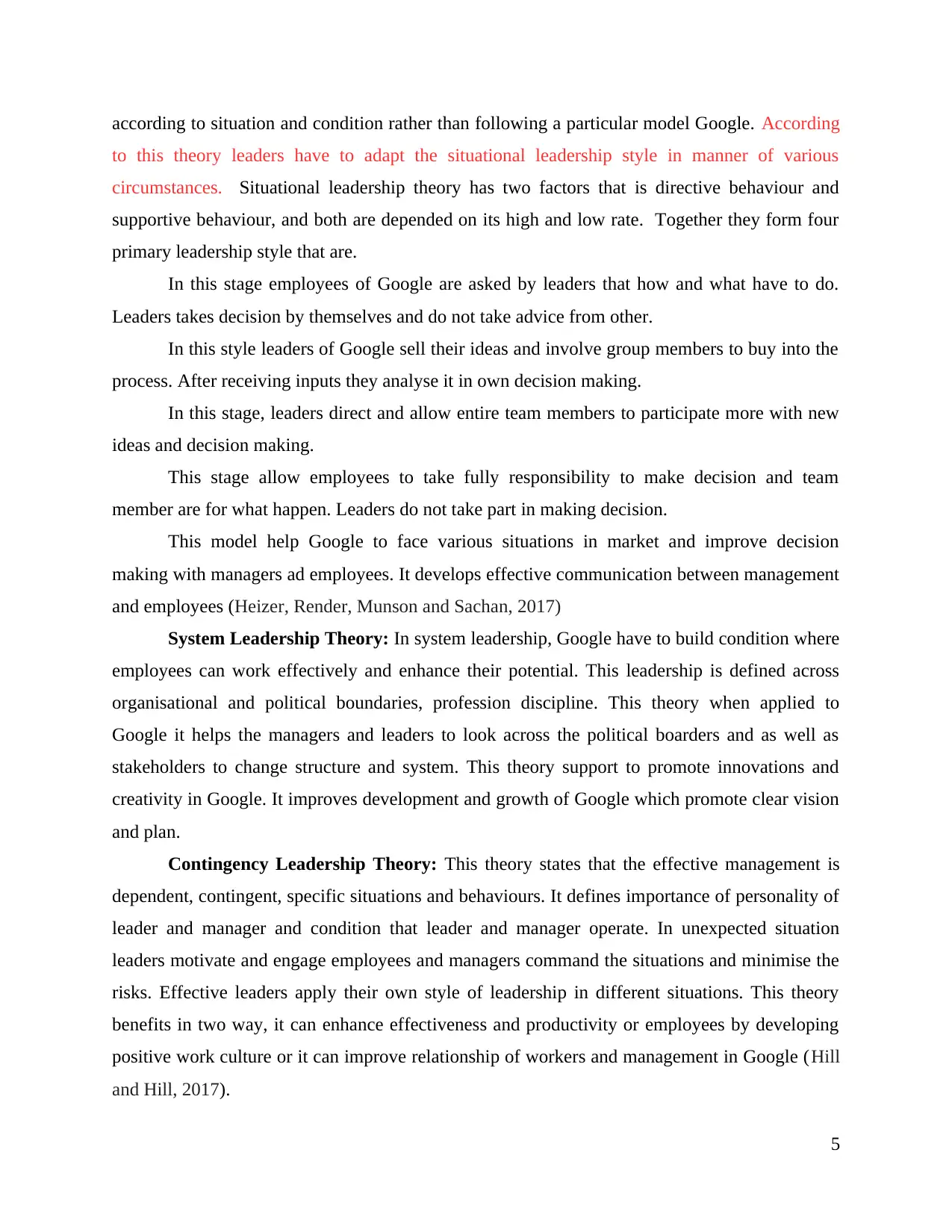
according to situation and condition rather than following a particular model Google. According
to this theory leaders have to adapt the situational leadership style in manner of various
circumstances. Situational leadership theory has two factors that is directive behaviour and
supportive behaviour, and both are depended on its high and low rate. Together they form four
primary leadership style that are.
In this stage employees of Google are asked by leaders that how and what have to do.
Leaders takes decision by themselves and do not take advice from other.
In this style leaders of Google sell their ideas and involve group members to buy into the
process. After receiving inputs they analyse it in own decision making.
In this stage, leaders direct and allow entire team members to participate more with new
ideas and decision making.
This stage allow employees to take fully responsibility to make decision and team
member are for what happen. Leaders do not take part in making decision.
This model help Google to face various situations in market and improve decision
making with managers ad employees. It develops effective communication between management
and employees (Heizer, Render, Munson and Sachan, 2017)
System Leadership Theory: In system leadership, Google have to build condition where
employees can work effectively and enhance their potential. This leadership is defined across
organisational and political boundaries, profession discipline. This theory when applied to
Google it helps the managers and leaders to look across the political boarders and as well as
stakeholders to change structure and system. This theory support to promote innovations and
creativity in Google. It improves development and growth of Google which promote clear vision
and plan.
Contingency Leadership Theory: This theory states that the effective management is
dependent, contingent, specific situations and behaviours. It defines importance of personality of
leader and manager and condition that leader and manager operate. In unexpected situation
leaders motivate and engage employees and managers command the situations and minimise the
risks. Effective leaders apply their own style of leadership in different situations. This theory
benefits in two way, it can enhance effectiveness and productivity or employees by developing
positive work culture or it can improve relationship of workers and management in Google (Hill
and Hill, 2017).
5
to this theory leaders have to adapt the situational leadership style in manner of various
circumstances. Situational leadership theory has two factors that is directive behaviour and
supportive behaviour, and both are depended on its high and low rate. Together they form four
primary leadership style that are.
In this stage employees of Google are asked by leaders that how and what have to do.
Leaders takes decision by themselves and do not take advice from other.
In this style leaders of Google sell their ideas and involve group members to buy into the
process. After receiving inputs they analyse it in own decision making.
In this stage, leaders direct and allow entire team members to participate more with new
ideas and decision making.
This stage allow employees to take fully responsibility to make decision and team
member are for what happen. Leaders do not take part in making decision.
This model help Google to face various situations in market and improve decision
making with managers ad employees. It develops effective communication between management
and employees (Heizer, Render, Munson and Sachan, 2017)
System Leadership Theory: In system leadership, Google have to build condition where
employees can work effectively and enhance their potential. This leadership is defined across
organisational and political boundaries, profession discipline. This theory when applied to
Google it helps the managers and leaders to look across the political boarders and as well as
stakeholders to change structure and system. This theory support to promote innovations and
creativity in Google. It improves development and growth of Google which promote clear vision
and plan.
Contingency Leadership Theory: This theory states that the effective management is
dependent, contingent, specific situations and behaviours. It defines importance of personality of
leader and manager and condition that leader and manager operate. In unexpected situation
leaders motivate and engage employees and managers command the situations and minimise the
risks. Effective leaders apply their own style of leadership in different situations. This theory
benefits in two way, it can enhance effectiveness and productivity or employees by developing
positive work culture or it can improve relationship of workers and management in Google (Hill
and Hill, 2017).
5
Paraphrase This Document
Need a fresh take? Get an instant paraphrase of this document with our AI Paraphraser
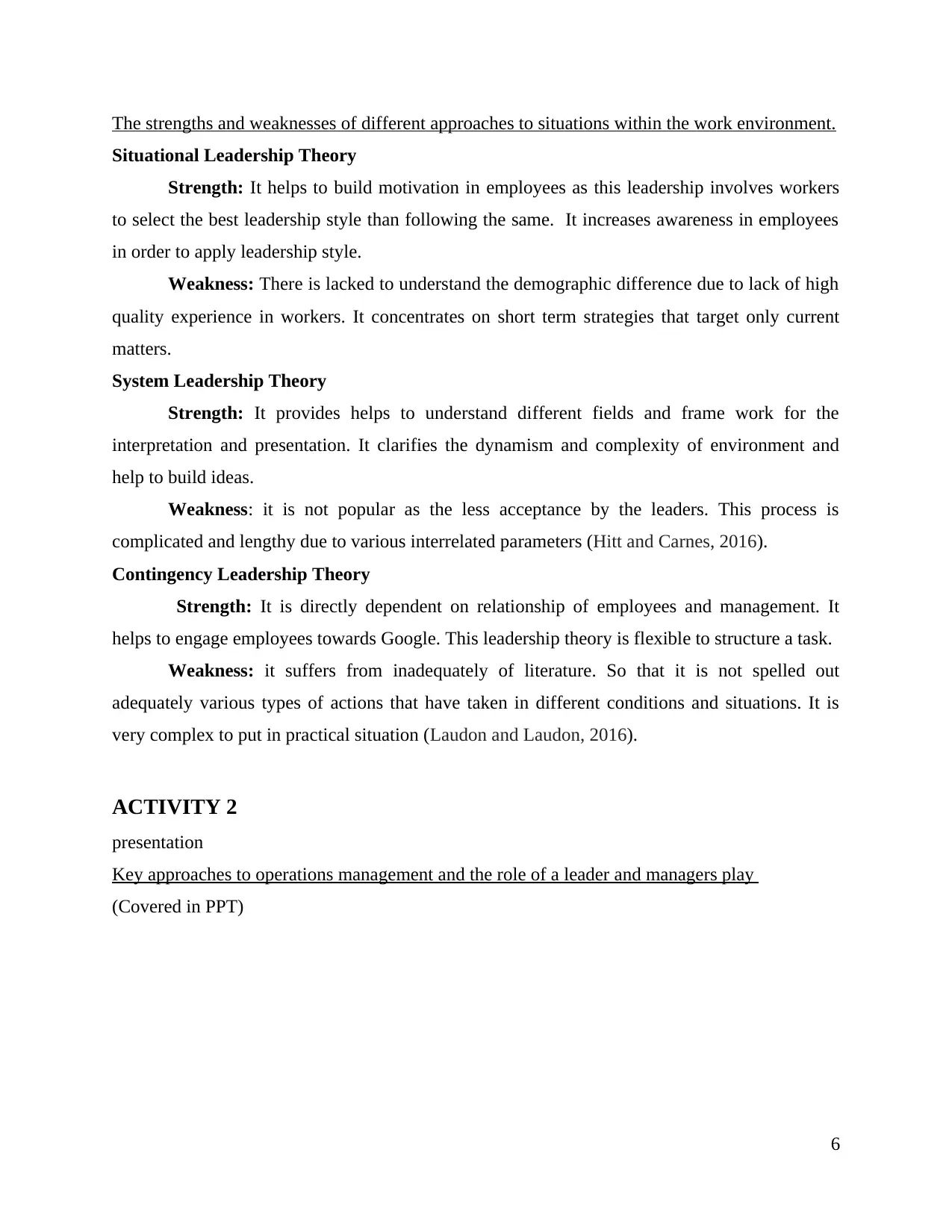
The strengths and weaknesses of different approaches to situations within the work environment.
Situational Leadership Theory
Strength: It helps to build motivation in employees as this leadership involves workers
to select the best leadership style than following the same. It increases awareness in employees
in order to apply leadership style.
Weakness: There is lacked to understand the demographic difference due to lack of high
quality experience in workers. It concentrates on short term strategies that target only current
matters.
System Leadership Theory
Strength: It provides helps to understand different fields and frame work for the
interpretation and presentation. It clarifies the dynamism and complexity of environment and
help to build ideas.
Weakness: it is not popular as the less acceptance by the leaders. This process is
complicated and lengthy due to various interrelated parameters (Hitt and Carnes, 2016).
Contingency Leadership Theory
Strength: It is directly dependent on relationship of employees and management. It
helps to engage employees towards Google. This leadership theory is flexible to structure a task.
Weakness: it suffers from inadequately of literature. So that it is not spelled out
adequately various types of actions that have taken in different conditions and situations. It is
very complex to put in practical situation (Laudon and Laudon, 2016).
ACTIVITY 2
presentation
Key approaches to operations management and the role of a leader and managers play
(Covered in PPT)
6
Situational Leadership Theory
Strength: It helps to build motivation in employees as this leadership involves workers
to select the best leadership style than following the same. It increases awareness in employees
in order to apply leadership style.
Weakness: There is lacked to understand the demographic difference due to lack of high
quality experience in workers. It concentrates on short term strategies that target only current
matters.
System Leadership Theory
Strength: It provides helps to understand different fields and frame work for the
interpretation and presentation. It clarifies the dynamism and complexity of environment and
help to build ideas.
Weakness: it is not popular as the less acceptance by the leaders. This process is
complicated and lengthy due to various interrelated parameters (Hitt and Carnes, 2016).
Contingency Leadership Theory
Strength: It is directly dependent on relationship of employees and management. It
helps to engage employees towards Google. This leadership theory is flexible to structure a task.
Weakness: it suffers from inadequately of literature. So that it is not spelled out
adequately various types of actions that have taken in different conditions and situations. It is
very complex to put in practical situation (Laudon and Laudon, 2016).
ACTIVITY 2
presentation
Key approaches to operations management and the role of a leader and managers play
(Covered in PPT)
6

7
⊘ This is a preview!⊘
Do you want full access?
Subscribe today to unlock all pages.

Trusted by 1+ million students worldwide

How leaders and managers can improve efficiencies of operational management to successfully
meet business objectives
(Covered in PPT)
8
meet business objectives
(Covered in PPT)
8
Paraphrase This Document
Need a fresh take? Get an instant paraphrase of this document with our AI Paraphraser
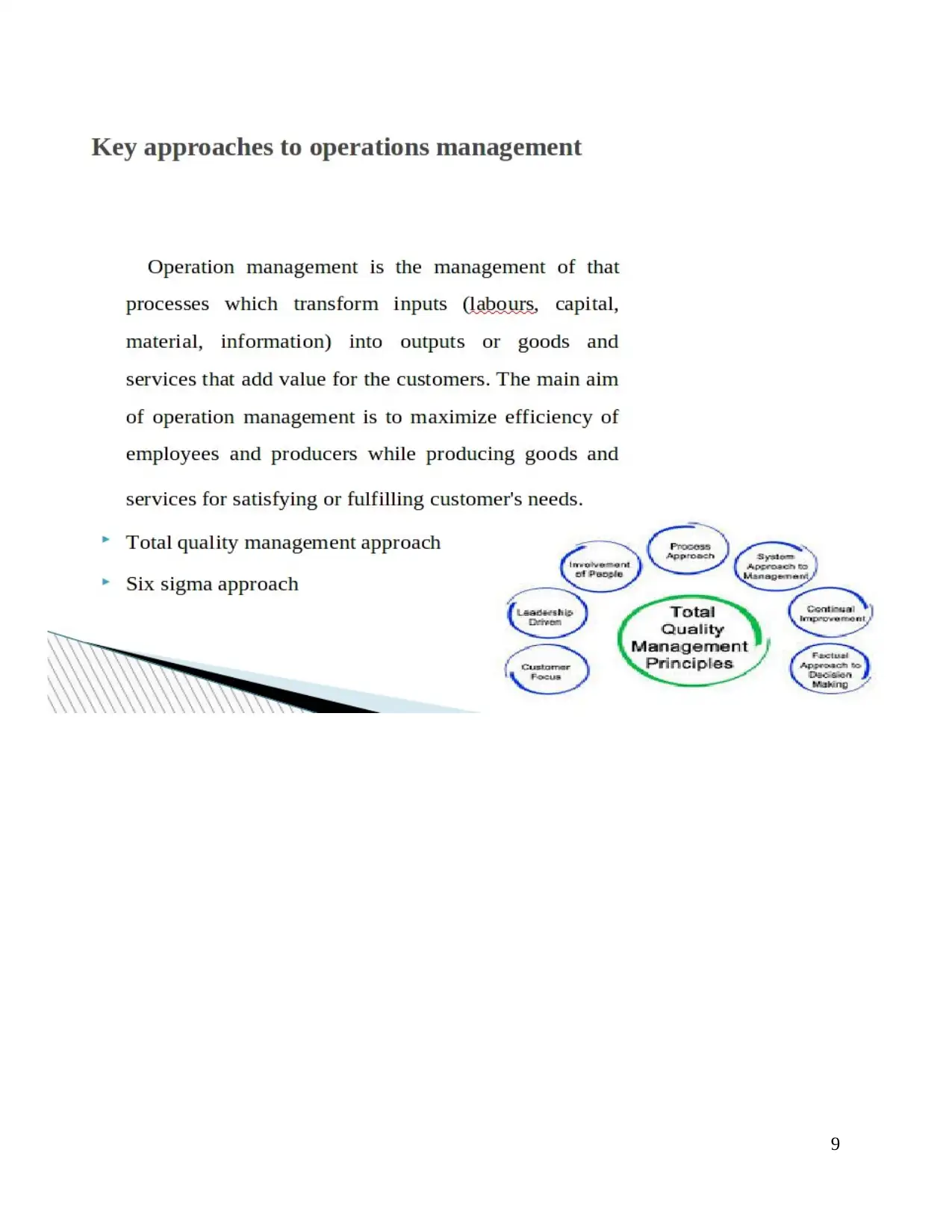
9
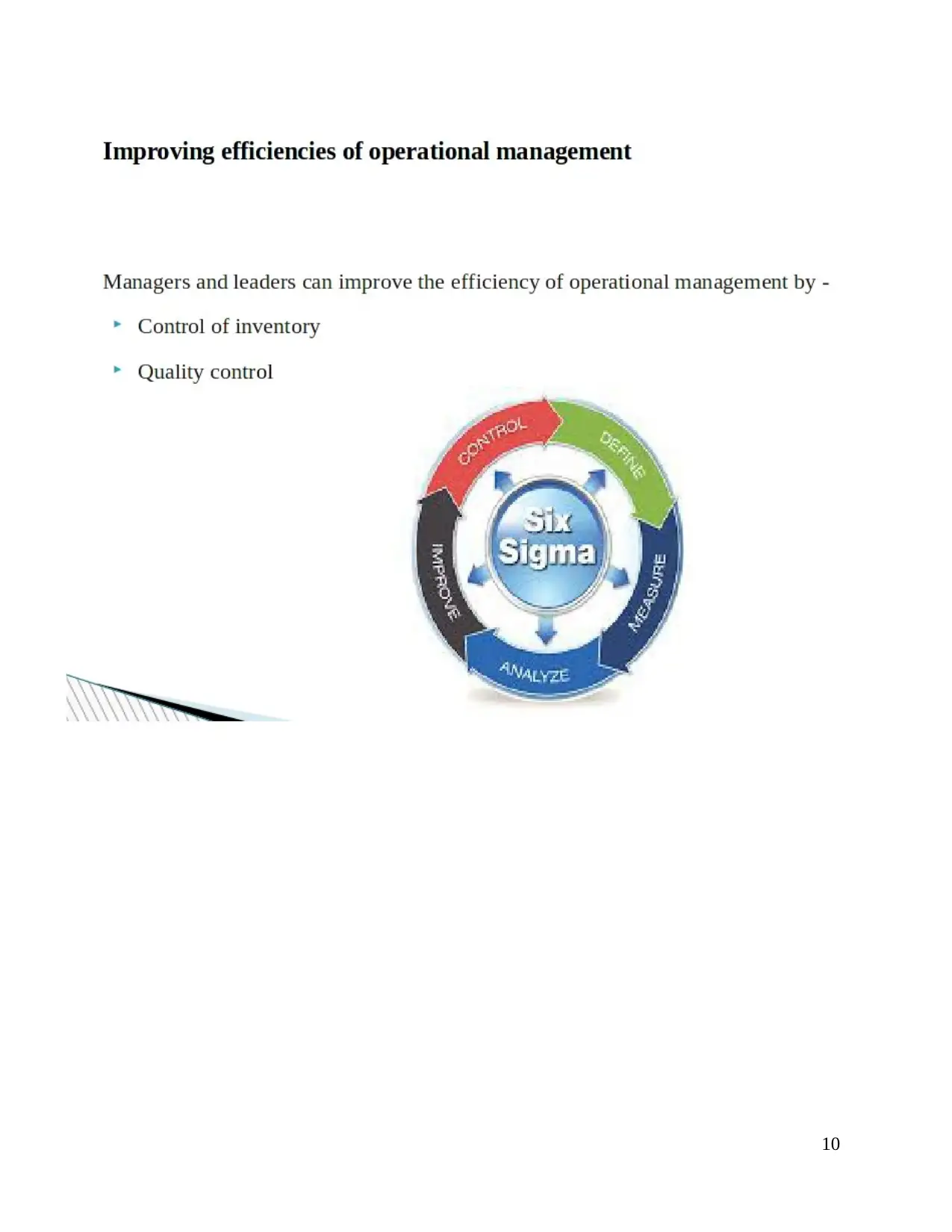
10
⊘ This is a preview!⊘
Do you want full access?
Subscribe today to unlock all pages.

Trusted by 1+ million students worldwide
1 out of 18
Related Documents
Your All-in-One AI-Powered Toolkit for Academic Success.
+13062052269
info@desklib.com
Available 24*7 on WhatsApp / Email
![[object Object]](/_next/static/media/star-bottom.7253800d.svg)
Unlock your academic potential
Copyright © 2020–2025 A2Z Services. All Rights Reserved. Developed and managed by ZUCOL.



